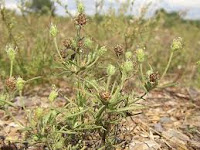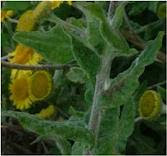Horseweed is the modern name for this plant which was called fleawort by Nicholas Culpeper, the 17th century English herbalist. As it had only been introduced into England in around 1640 he can be forgiven for his rather fanciful rationale for its name. The truth is that, like fleabane, it repels insects when burned. It is native to North America , although it has naturalized in Britain now and in most of the rest of Europe . This is what Culpeper has to say of this plant.

 “Government and virtues. The herb is cold, and dry, and saturnine. I suppose it obtained the name of Flea-wort, because the seeds are so like Fleas. The seeds fried, and taken, stays the flux or lask of the belly, and the corrosions that come by reason of hot choleric, or sharp and malignant humours, or by too much purging of any violent medicine, as Scammony, or the like. The mucilage of the seed made with Rose-water, and a little sugar-candy put thereto, is very good in all hot agues and burning fevers, and other inflammations, to cool the thirst, and lenify the dryness and roughness of the tongue and throat. It helps also hoarseness of the voice, and diseases of the breast and lungs, caused by heat, or sharp salt humours, and the pleurisy also. The mucilage of the seed made with Plantain water, whereunto the yoke of an egg or two, and a little Populeon are put, is a most safe and sure remedy to ease the sharpness, pricking, and pains of the hæmorrhoids or piles, if it be laid on cloth, and bound thereto. It helps all inflammations in any part of the body, and the pains that come thereby, as the headache and megrims, and all hot imposthumes, swellings, or breaking out of the skin, as blains, wheals, pushes, purples, and the like, as also the joints of those that are out of joint, the pains of the gout and sciatica, the burstings of young children, and the swellings of the navel, applied with oil of roses and vinegar. It is also good to heal the nipples and sore breasts of women, being often applied there-unto. The juice of the herb with a little honey put into the ears helps the running of them, and the worms breeding in them. The same also mixed with hog's grease, and applied to corrupt and filthy ulcers, cleanses them and heals them.”
“Government and virtues. The herb is cold, and dry, and saturnine. I suppose it obtained the name of Flea-wort, because the seeds are so like Fleas. The seeds fried, and taken, stays the flux or lask of the belly, and the corrosions that come by reason of hot choleric, or sharp and malignant humours, or by too much purging of any violent medicine, as Scammony, or the like. The mucilage of the seed made with Rose-water, and a little sugar-candy put thereto, is very good in all hot agues and burning fevers, and other inflammations, to cool the thirst, and lenify the dryness and roughness of the tongue and throat. It helps also hoarseness of the voice, and diseases of the breast and lungs, caused by heat, or sharp salt humours, and the pleurisy also. The mucilage of the seed made with Plantain water, whereunto the yoke of an egg or two, and a little Populeon are put, is a most safe and sure remedy to ease the sharpness, pricking, and pains of the hæmorrhoids or piles, if it be laid on cloth, and bound thereto. It helps all inflammations in any part of the body, and the pains that come thereby, as the headache and megrims, and all hot imposthumes, swellings, or breaking out of the skin, as blains, wheals, pushes, purples, and the like, as also the joints of those that are out of joint, the pains of the gout and sciatica, the burstings of young children, and the swellings of the navel, applied with oil of roses and vinegar. It is also good to heal the nipples and sore breasts of women, being often applied there-unto. The juice of the herb with a little honey put into the ears helps the running of them, and the worms breeding in them. The same also mixed with hog's grease, and applied to corrupt and filthy ulcers, cleanses them and heals them.” It was boiled and used in sweat lodges by the Native Americans, and a decoction of the plant was traditionally used against cancer. The Native Americans also used the powdered herb as snuff to clear the head when they had colds. In Chinese medicine it has been used for wounds, swellings and the pain caused by arthritis. In
It was boiled and used in sweat lodges by the Native Americans, and a decoction of the plant was traditionally used against cancer. The Native Americans also used the powdered herb as snuff to clear the head when they had colds. In Chinese medicine it has been used for wounds, swellings and the pain caused by arthritis. In The whole herb can be used and should be gathered and dried for later use. It was formerly called Erigeron canadensis with erigeron describing it appearance of being past its prime as soon as it flowers (eri being Greek for early and geros or geron meaning old man). It contains a volatile oil which is used for flavouring soft drinks, sweets and in perfumery.
 Horseweed is a member of the Asteraceae or Compositae family, which makes it a relative of such plants as fleabane, pellitory or Roman chamomile, marigolds, purple goat’s beard (salsify), yellow goat’s beard, elecampane, the ox-eye daisy, holy thistles, costmary, tansy, feverfew, groundsel and yarrow, among others. Its leaves are edible and can be eaten in salads or cooked as a vegetable like spinach. They contain the minerals calcium, phosphorous, and potassium in fairly high proportions.
Horseweed is a member of the Asteraceae or Compositae family, which makes it a relative of such plants as fleabane, pellitory or Roman chamomile, marigolds, purple goat’s beard (salsify), yellow goat’s beard, elecampane, the ox-eye daisy, holy thistles, costmary, tansy, feverfew, groundsel and yarrow, among others. Its leaves are edible and can be eaten in salads or cooked as a vegetable like spinach. They contain the minerals calcium, phosphorous, and potassium in fairly high proportions. It has been the subject of several clinical studies which have found it to have antifungal and antimicrobial activities. A methanolic extract of the plant has “exhibited important antibacterial activity” and “good antioxidant activity” while the “ethyl acetate and petroleum ether extracts demonstrated effective cytotoxic activity against Hep-2 cells.” (Medical Chemistry Research Vol.18 (6) 2009, pp 447-458 “Antibacterial, antioxidant and cytotoxic activities of extracts of Conyza canadensis (L) Cronquist growing in Tunisia” Edzir Hayat et al.)
 Another study by Beata Olas et al. (2006) “Antioxidant and antiaggregating effects of an extract from Conyza canadensis on blood platelets in vitro” also found that “the natural polysaccharide extract from Conyza canadensis has antiaggregatory and antioxidative activities and therefore may be beneficial in the prevention of peroxynitrite-related diseases, such as cardio-vascular and inflammatory diseases.”
Another study by Beata Olas et al. (2006) “Antioxidant and antiaggregating effects of an extract from Conyza canadensis on blood platelets in vitro” also found that “the natural polysaccharide extract from Conyza canadensis has antiaggregatory and antioxidative activities and therefore may be beneficial in the prevention of peroxynitrite-related diseases, such as cardio-vascular and inflammatory diseases.” Yet another study conducted in Hungary by Boglárka Csupor-Lôffler et al. “Antiproliferative Constituents of the Roots of Conyza canadensis” (2011) found the extracts to have “considerable cell-growth inhibitory activity against human cervix adenocarcinoma (HeLa), skin carcinoma (A431) and breast adenocarcinoma (MCF-7) cells.”
 Clearly this plant has a lot of potential benefits for us and research is continuing into its properties.
Clearly this plant has a lot of potential benefits for us and research is continuing into its properties.














































